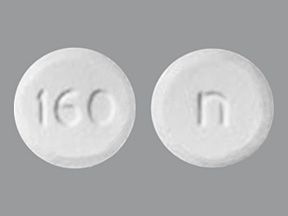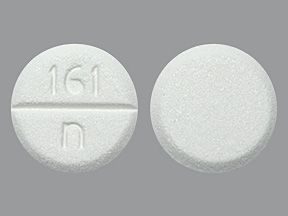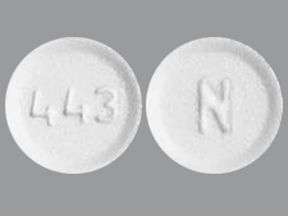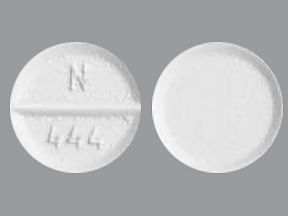Misoprostol is a generic prescription drug. It’s FDA-approved to reduce the risk of gastric (stomach) ulcers caused by nonsteroidal anti-inflammatory drugs (NSAIDs). The drug is used for this purpose in adults.
For more information, see the “Misoprostol oral tablet uses” section below.
Drug details
Misoprostol comes as an oral tablet that’s taken by mouth. It’s available in two strengths: 100 micrograms (mcg) and 200 mcg.
Misoprostol belongs to a class of drugs called prostaglandin analogs.
Brand-name versions
Misoprostol oral tablet is the generic version of the brand-name drug Cytotec.
Generic vs. brand-name
Misoprostol is a generic drug. A generic drug is an exact copy of the active drug in a brand-name medication. Cytotec is the brand-name medication that misoprostol is based on. A generic is considered to be as safe and effective as the original drug. Generics tend to cost less than brand-name drugs.
If you’re interested in taking Cytotec instead of misoprostol, talk with your doctor. They can tell you if Cytotec comes in forms and strengths they can prescribe for your condition. If you have health insurance, you’ll also need to check whether your plan will cover Cytotec.
To learn more about how generics compare with brand-name drugs, see this article.
Some doctors and pharmacies in certain U.S. states may restrict access to misoprostol. This is because of the risk of legal problems due to the overturn of Roe v. Wade. If you need help obtaining your prescription, ask your doctor or pharmacist about other pharmacies or alternative medications.
Here are answers to some frequently asked questions about misoprostol.
Is misoprostol used to induce a medical abortion?
Yes, misoprostol can be prescribed off-label to induce a medical abortion. Off-label drug use is when an FDA-approved drug is prescribed for a purpose other than what it’s approved for.
Medical abortion refers to the use of medication to end a pregnancy. Misoprostol may be prescribed to end an early pregnancy of 10 weeks or less. For this purpose, doctors prescribe it on its own or in combination with mifepristone (Mifeprex).
Keep in mind that misoprostol has a
If you have questions about the use of misoprostol for medical abortion, talk with your doctor.
Does misoprostol cause vaginal side effects? If so, could these side effects affect a future pregnancy?
Yes, misoprostol may cause certain vaginal side effects, such as vaginal cramps. However, these side effects aren’t thought to affect a future pregnancy or result in damage to the womb.
Based on the results of animal studies, misoprostol could affect fertility (the ability to become or continue with a pregnancy). However, animal studies don’t always predict what will happen in humans. In fact, a study of people given misoprostol after pregnancy loss* didn’t show any effects on future fertility.
If you have questions about the vaginal side effects of misoprostol or how the drug may affect a future pregnancy, talk with your doctor.
* This is an off-label use of misoprostol. Off-label drug use is when an FDA-approved drug is prescribed for a purpose other than what it’s approved for. To learn more about off-label uses for the drug, see the “Misoprostol oral tablet and pregnancy” section below.
How does misoprostol compare with mifepristone?
Below are a few ways misoprostol compares with mifepristone (Mifeprex).
Mifepristone is approved by the Food and Drug Administration (FDA) to induce a medical abortion. (Medical abortion refers to the use of medication to end a pregnancy.) It’s prescribed to end an early pregnancy of 10 weeks or less. For this use, doctors prescribe mifepristone in combination with misoprostol.
Mifepristone works to end a pregnancy by blocking a hormone called progestin. Without this hormone, the uterus cannot support a pregnancy.
Misoprostol is FDA-approved to reduce the risk of gastric (stomach) ulcers caused by nonsteroidal anti-inflammatory drugs (NSAIDs).
The drug can be prescribed off-label to induce a medical abortion in early pregnancy. Off-label drug use is when an FDA-approved drug is prescribed for a purpose other than what it’s approved for. For this purpose, doctors may prescribe misoprostol on its own or in combination with mifepristone.
Misoprostol works to end a pregnancy by mimicking the activity of a hormone called prostaglandin. One function of this hormone is to cause the uterus to contract. By acting similarly to this hormone, misoprostol causes the uterus to contract and empty.
If you have more questions about how misoprostol compares with mifepristone, talk with your doctor.
Why is misoprostol prescribed before an intrauterine device (IUD) is inserted?
In some cases, misoprostol may be used before the placement of an intrauterine device (IUD). IUDs are small devices inserted into the uterus by a healthcare professional. They’re used to help prevent pregnancy.
When used for this purpose, misoprostol helps ease IUD placement. It works by widening the cervix to make placement of the IUD easier and help reduce pain that may occur during insertion.
IUD insertion is an off-label use for misoprostol. Off-label drug use is when an FDA-approved drug is prescribed for a purpose other than what it’s approved for.
To learn more about misoprostol’s use before IUD insertion, talk with your doctor.
Is there a 400-mcg dose of misoprostol?
Misoprostol doesn’t have an approved dosage of 400 micrograms (mcg).
Misoprostol is approved to reduce the risk of gastric (stomach) ulcers caused by nonsteroidal anti-inflammatory drugs (NSAIDs). For this purpose, the usual dosage is 200 mcg four times per day.
Misoprostol is sometimes prescribed off-label for other conditions. Off-label drug use is when an FDA-approved drug is prescribed for a purpose other than what it’s approved for. To learn about the usual dosages for misoprostol’s off-label uses, talk with your doctor.
Misoprostol can cause mild or serious side effects. The following lists contain some of the key side effects that may occur while taking misoprostol. These lists do not include all possible side effects.
For more information about the possible side effects of misoprostol, talk with your doctor or pharmacist. They can give you tips on managing any side effects that may be concerning or bothersome.
Note: The Food and Drug Administration (FDA) tracks side effects of drugs it has approved. If you’d like to notify the FDA about a side effect you’ve had with misoprostol, you can do so through MedWatch.
Mild side effects
Below is a partial list of mild side effects of misoprostol. To learn about other mild side effects, talk with your doctor or pharmacist, or view misoprostol’s prescribing information.
Mild side effects of misoprostol can include:
- digestive side effects, such as:
- abdominal pain
- indigestion
- flatulence (gas)
- constipation
- nausea and vomiting
- mild diarrhea
- headache
- vaginal cramps
- nonperiod spotting
- heavy menstrual bleeding
- period pain
- mild allergic reaction*
Most of these side effects may go away within a few days to a couple of weeks. However, if they become more severe or don’t go away, talk with your doctor or pharmacist.
* For more information about allergic reaction and misoprostol, see “Allergic reaction” below.
Serious side effects
Serious side effects from misoprostol aren’t common, but they can occur. Call your doctor right away if you have serious side effects. Call 911 or your local emergency number if your symptoms feel life threatening or if you think you’re having a medical emergency.
Serious side effects can include:
- severe diarrhea that leads to dehydration
- risk of harm if taken during pregnancy*
- severe allergic reaction†
* Misoprostol has a
† For details about allergic reaction and misoprostol, see “Allergic reaction” below.
ALLERGIC REACTIONAs with most drugs, some people can have an allergic reaction after taking misoprostol. This was a rare side effect in clinical trials of this drug.
Symptoms of a mild allergic reaction can include:
A more severe allergic reaction is rare but possible. Symptoms of a severe allergic reaction can include:
- swelling under your skin, typically in your eyelids, lips, hands, or feet
- swelling of your tongue, mouth, or throat
- trouble breathing
Call your doctor right away if you have an allergic reaction to misoprostol, as the reaction could become severe. Call 911 or your local emergency number if your symptoms feel life threatening or if you think you’re having a medical emergency.
Below is important information about taking misoprostol during pregnancy.
Risk of harm if taken during pregnancy
Misoprostol has a
Misoprostol may cause pregnancy loss. This is because the drug works by mimicking the activity of a hormone called prostaglandin. One function of this hormone is to cause the uterus to contract. When taken during pregnancy, misoprostol can cause the uterus to contract and empty. This results in pregnancy loss.
If pregnancy loss doesn’t occur, the use of misoprostol during pregnancy may lead to congenital anomalies (also known as birth defects) that can be fatal. Examples include weakened cranial nerves and problems with the development of the head, face, arms, or legs.
To learn more about this risk, talk with your doctor.
Misoprostol and pregnancy
Misoprostol is not safe to take during pregnancy because the drug can cause pregnancy loss. (For details, see “Risk of harm if taken during pregnancy” above.)
Misoprostol is used to reduce the risk of gastric (stomach) ulcers caused by nonsteroidal anti-inflammatory drugs (NSAIDs). Due to the risk of harm, doctors won’t prescribe misoprostol for this use during pregnancy.
If you’re able to become pregnant, your doctor will likely have you take a pregnancy test within 2 weeks before you start misoprostol treatment. This is to confirm that you’re not pregnant.
If you become pregnant while taking misoprostol, stop taking the drug and tell your doctor right away. They’ll likely recommend a different treatment option for your condition during pregnancy.
Misoprostol and fertility
It isn’t known whether misoprostol affects fertility (the ability to become or continue with a pregnancy).
Animal studies have shown that misoprostol may affect fertility. However, animal studies do not always predict what will happen in humans.
If you’re concerned about how misoprostol might affect your fertility, talk with your doctor.
Misoprostol and off-label uses, such as for inducing a medical abortion
Misoprostol is approved to reduce the risk of gastric ulcers caused by NSAIDs. However, the drug is sometimes prescribed off-label for other uses. Off-label drug use is when an FDA-approved drug is prescribed for a purpose other than what it’s approved for.
For example, misoprostol may be prescribed off-label to induce a medical abortion. (Medical abortion refers to the use of medication to end a pregnancy.) The drug can be prescribed to end an early pregnancy in the first trimester, usually before week 10 of pregnancy.
For this use, misoprostol may be swallowed whole or placed between your cheek and gum. Or you may be advised to have the tablets inserted vaginally.
Misoprostol may be prescribed for other off-label uses, such as helping the uterus empty after pregnancy loss. It can also be used off-label for cervical ripening (the process of opening and softening the cervix before labor) and to induce labor.
If you have questions about misoprostol’s off-label uses, talk with your doctor.
Below is important information about taking misoprostol while breastfeeding.
Misoprostol and breastfeeding
Misoprostol passes into breast milk. However, it isn’t known if the drug may cause side effects in a child who is breastfed.
If you’re breastfeeding or planning to do so, talk with your doctor. They can advise you on the risks and benefits of taking the drug during this time.
Misoprostol is not safe to take during pregnancy. If you’re sexually active and you or your partner can become pregnant, talk with your doctor about your birth control needs while using misoprostol.
For more information about taking misoprostol during pregnancy, see the “Misoprostol oral tablet and pregnancy” section above.
For females using misoprostol. Females* who can become pregnant should use birth control while taking misoprostol. If you have questions, talk with your doctor about the birth control method that’s best for you.
For males using misoprostol. The manufacturer of misoprostol hasn’t given birth control recommendations for males* taking the drug. If you’re a male taking misoprostol and have a sexual partner who can become pregnant, talk with your doctor. They’ll advise you on your birth control needs while taking this drug.
* Sex and gender exist on spectrums. Use of the term “female” and “male” in this article refers to sex assigned at birth.
You should take misoprostol according to the instructions your doctor gives you.
Misoprostol comes as an oral tablet that you take by mouth.
Misoprostol is taken in combination with nonsteroidal anti-inflammatory drugs (NSAIDs). Doctors prescribe the drug to reduce the risk of gastric (stomach) ulcers caused by NSAIDs. To learn more, see the “Misoprostol oral tablet uses” section below.
When to take
You’ll likely take misoprostol four times per day. You should take each dose about 6 hours apart, with your last dose at bedtime.
Try to take your doses around the same time each day. This helps keep a steady level of the drug in your body, which helps misoprostol work effectively.
To help make sure that you don’t miss a dose, try using a medication reminder. This can include setting an alarm or using a timer. You could also download a reminder app on your phone.
Accessible labels and containers
If your prescription label is hard to read, talk with your doctor or pharmacist. Some pharmacies offer labels that have large print, braille, or a code you scan with a smartphone to convert text to speech. If your local pharmacy doesn’t have these options, your doctor or pharmacist may be able to direct you to one that does.
If you have trouble opening medication bottles, ask your pharmacist if they can put misoprostol in an easy-open container. They also may be able to recommend tools that can make it simpler to open lids.
Taking misoprostol with food
You’ll take misoprostol with food. Doing so will help reduce your risk of digestive side effects, such as abdominal pain and diarrhea.
Can misoprostol be crushed, split, or chewed?
The manufacturer of misoprostol hasn’t stated whether the drug can be crushed, split, or chewed.
If you have trouble swallowing misoprostol tablets whole, talk with your doctor or pharmacist.
Misoprostol can interact with several other medications.
Different interactions can cause different effects. For instance, some interactions can interfere with how well a drug works. Other interactions can increase side effects or make them more severe. Drug-condition interactions can also cause certain effects. For information about these interactions, see the “Misoprostol oral tablet precautions” section below.
Misoprostol and other medications
Before taking misoprostol, talk with your doctor and pharmacist. Tell them about all prescription, over-the-counter, and other drugs you take. Also tell them about any vitamins, herbs, and supplements you use. Sharing this information can help you avoid potential interactions.
Below is a table of medications that can interact with misoprostol. This table doesn’t contain all drugs that may interact with misoprostol.
| Medication type or medication name | Medication examples |
| certain antacids | • aluminum hydroxide/magnesium hydroxide (Maalox) • aluminum hydroxide/magnesium hydroxide/simethicone (Mylanta) |
| oxytocin (Pitocin) | — |
Your doctor or pharmacist can provide more information about the interactions between these medications and misoprostol. If you have questions about any drug interactions that may affect you, your doctor or pharmacist can also address those.
Other interactions, including foods
Misoprostol is not known to interact with herbs, supplements, or foods. However, this doesn’t mean that interactions won’t be recognized in the future.
Before starting misoprostol treatment, talk with your doctor and pharmacist. Tell them about any vitamins, herbs, and supplements you take. Sharing this information can help you avoid potential interactions.
If you have questions about interactions that may affect you, talk with your doctor or pharmacist.
The Food and Drug Administration (FDA) approves prescription drugs such as misoprostol to treat certain conditions. Misoprostol may also be used off-label for other conditions. Off-label drug use is when an FDA-approved drug is prescribed for a purpose other than what it’s approved for.
Misoprostol for gastric ulcers
Misoprostol is FDA-approved to reduce the risk of gastric (stomach) ulcers caused by nonsteroidal anti-inflammatory drugs (NSAIDs) in adults.
Gastric ulcers explained
With gastric ulcers, you have holes or sores in the lining of your stomach. This can lead to symptoms such as indigestion, nausea and vomiting, and loss of appetite.
NSAIDs are a common cause of gastric ulcers. NSAIDs are a class of drugs used to treat pain and inflammation. Examples include:
Misoprostol is taken in combination with NSAIDs to reduce the risk of gastric ulcers with these medications.
Misoprostol and children
Misoprostol is not FDA-approved for use in children. It’s not known for sure whether misoprostol is safe or effective for children.
The misoprostol dosage your doctor prescribes will depend on certain factors. These include whether your body is able to tolerate the drug without having bothersome side effects.
The following information describes dosages that are commonly used or recommended. However, be sure to take the dosage your doctor prescribes for you. Your doctor will determine the best dosage to fit your needs.
Dosage for gastric ulcers
Misoprostol is used to reduce the risk of gastric (stomach) ulcers caused by nonsteroidal anti-inflammatory drugs (NSAIDs). Here’s the misoprostol dosage information for this use. The tablets are measured in micrograms (mcg).
| Misoprostol for gastric ulcers | |
| Form and route | oral tablet that’s swallowed |
| Strengths | • 100 mcg • 200 mcg |
| Dose | 200 mcg |
| How often | 4 times per day |
| Administered by | self |
What if I miss a dose?
If you miss a dose of misoprostol, take your missed dose as soon as you remember. But if it’s almost time for your next dose, just skip your missed dose and take your next dose at its usual time.
Do not take any extra doses of misoprostol to make up for a missed dose. Doing so can raise your risk for side effects from the drug. For lists of possible side effects, see the “Misoprostol oral tablet side effects” section above.
To help make sure that you don’t miss a dose, try using a medication reminder. This can include setting an alarm or using a timer. You could also download a reminder app on your phone.
Will I need to use this drug long term?
Misoprostol can be used as a long-term treatment. If you and your doctor determine that misoprostol is safe and effective for you, you’ll likely take it long term.
There’s no known interaction between misoprostol and alcohol.
However, drinking alcohol can increase the risk of gastric (stomach) ulcers. Doctors prescribe misoprostol to reduce the risk of gastric ulcers caused by nonsteroidal anti-inflammatory drugs (NSAIDs). So it’s possible that drinking alcohol while taking the drug could make it hard to tell whether misoprostol is working for you.
If you drink alcohol, talk with your doctor before taking misoprostol. They can advise you on whether you should limit the amount of alcohol you consume during misoprostol treatment.
As with all medications, the cost of misoprostol can vary. The actual price you’ll pay depends on your insurance plan, your location, and the pharmacy you use. To learn more about the cost of misoprostol, see this article.
Keep in mind that you may be able to get a 90-day supply of misoprostol. If approved by your insurance company, getting a 90-day supply of the drug could reduce your number of trips to the pharmacy and help lower the cost. If you’re interested in this option, check with your doctor, pharmacist, or insurance company.
Before approving coverage for misoprostol, your insurance company may require you to get prior authorization. This means that your doctor and insurance company will need to communicate about your prescription before the insurance company will cover the drug. The insurance company will review the prior authorization request and decide if the drug will be covered.
If you’re not sure whether you’ll need prior authorization for misoprostol, contact your insurance company.
Financial and insurance assistance
Financial assistance to help you pay for misoprostol may be available.
Medicine Assistance Tool and NeedyMeds are two websites offering resources that may help decrease the price you pay for misoprostol. They also offer tools to help you find low cost healthcare, as well as educational resources. To learn more, visit their sites.
Mail-order pharmacies
Misoprostol may be available through a mail-order pharmacy. Using this service may help lower the drug’s cost and allow you to get your medication without leaving home.
If recommended by your doctor, you may be able to receive a 90-day supply of misoprostol, so there’s less concern about running out of the medication. If you’re interested in this option, check with your doctor, pharmacist, or insurance company. Some Medicare plans may help cover the cost of mail-order medications.
If you don’t have insurance, you can ask your doctor or pharmacist about online pharmacy options.
This drug comes with several precautions. These are considered drug-condition interactions.
FDA warning: Risk of harm if taken during pregnancy
This drug has a
Risk of harm if taken during pregnancy. When taken during pregnancy, misoprostol may cause pregnancy loss. The drug may also lead to congenital anomalies (commonly known as birth defects) that can be fatal.
For more information on this warning, see the “Misoprostol oral tablet and pregnancy” section above.
Other precautions
In addition to the boxed warnings mentioned above, misoprostol has other warnings.
If any of the following medical conditions or other health factors pertain to you, be sure to talk with your doctor before taking misoprostol.
- if you’re pregnant or thinking about becoming pregnant
- if you’re breastfeeding or thinking about breastfeeding
- if you’ve had an allergic reaction to either drug or any of its ingredients
- if you have inflammatory bowel disease
- if you have heart disease, such as a history of heart attack
Note: For more information about the potential negative effects of misoprostol, see the “Misoprostol oral tablet side effects” section above.
Using more than the recommended dosage of misoprostol can lead to serious side effects. Do not use more misoprostol than your doctor recommends. (For information on the recommended dosages of misoprostol, see the “Misoprostol oral tablet dosage” section above.)
Overdose symptoms
Symptoms of an overdose can include:
- digestive problems, such as abdominal pain and diarrhea
- sleepiness
- convulsions or tremors
- shortness of breath
- fever
- heart palpitations
- low blood pressure
- slow heart rate
What to do in case of overdose
If you think you’ve taken too much of this drug, call your doctor. You can also call the American Association of Poison Control Centers at 800-222-1222 or use its online tool. However, if your symptoms are severe, call 911 or your local emergency number, or go to the nearest emergency room right away.
When you get misoprostol from the pharmacy, the pharmacist will add an expiration date to the label on the bottle. This date is typically 1 year from the date they dispensed the medication.
The expiration date helps guarantee that the medication is effective during this time. The
Storage
How long a medication remains good can depend on many factors, including how and where you store the medication.
Misoprostol tablets should be stored at a temperature of 68°F to 77°F (20°C to 25°C) in a tightly sealed container. For short periods of time, such as when traveling, misoprostol tablets may be stored at temperatures of 59°F to 86°F (15°C to 30°C). Avoid storing this medication in areas where it could get damp or wet, such as bathrooms.
Disposal
If you no longer need to take misoprostol and have leftover medication, it’s important to dispose of it safely. This helps prevent others, including children and pets, from taking the drug by accident. It also helps keep the drug from harming the environment.
This article provides several useful tips on medication disposal. You can also ask your pharmacist for information about how to dispose of your medication.
Disclaimer: Medical News Today has made every effort to make certain that all information is factually correct, comprehensive, and up to date. However, this article should not be used as a substitute for the knowledge and expertise of a licensed healthcare professional. You should always consult your doctor or another healthcare professional before taking any medication. The drug information contained herein is subject to change and is not intended to cover all possible uses, directions, precautions, warnings, drug interactions, allergic reactions, or adverse effects. The absence of warnings or other information for a given drug does not indicate that the drug or drug combination is safe, effective, or appropriate for all patients or all specific uses.






